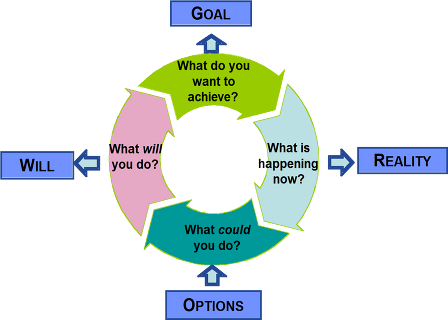
As most of the country, and the world, self-quarantines to try and flatten the curve of the coronavirus, I’ve found that many of my clients are taking it one of two ways; some are using this opportunity at home to develop new life goals and improve themselves as individuals and professionals. Others are finding that the lack of structure – going into the office each day – and remote working has become detrimental to them. Honestly, the allure of Netflix is more attractive than self-improvement.
For those of you who fall into category #2, I want to share a tried and true method for getting yourself back on track: The GROW Model.
The Grow Model has been around for decades, for good reason. By brainstorming solutions to each section you can help identify your goals, the factors that stand in your way to achieving those goals, your options to move forward, and your to-do list for taking the next steps and knocking those goals out of the park!
So let’s break down the GROW Model and get started taking steps to achieving your goals!
G – GOAL
The first step is to define your goal. What is it that you want to achieve? What is your ideal state? This is the basis for the entire framework so think long and hard on what you want your goal to be.
R – Reality
R stands for “reality” as in, the reality of your current situation. Define where you are currently and be as realistic as possible – the only person you’re short changing in this step is yourself.
O – Options
Next you will want to lay out options for yourself. Let’s say your original goal was to be a real-estate agent and one of your realities is that you are working a day job from 9-5. One of your options might be night classes or online classes in order to get your certification. Perhaps you could use vacation leave to spend a week doing in-person classes?
List every option from the most far-fetched to the most realistic and then deliberate on the next steps.
W – Will
You’ve set your ideal state. You’ve identified your reality of what is keeping you from achieving that goal. Then you listed all of your options to achieve that goal.
Now, pick the most realistic method and state what you will do next!
That’s it, that’s the GROW Model! It’s really that simple.
If you need some additional help, here are 20 questions designed to clarify the current reality:
1. What is happening now (what, who, when, and how often)?
2. Have you already taken any steps towards your goal?
3. How would you describe what you did?
4. Where are you now in relation to your goal?
5. On a scale of one to ten where are you?
6. What has contributed to your success so far?
7. What progress have you made so far?
8. What is working well right now?
9. What is required of you?
10. Why haven’t you reached that goal already?
11. What do you think is stopping you?
12. What do you think was really happening?
13. Do you know other people who have achieved that goal?
14. What did you learn from _____?
15. What have you already tried?
16. How could you turn this around this time?
17. What could you do better this time?
18. If you asked ____, what would they say about you?
19. On a scale of one to ten how severe/serious/urgent is the situation?
20. If someone said/did that to you, what would you think/feel/do?
Options: Once you both have a clear understanding of the situation, the coaching conversation turns to what the employee can do to reach their goal.
Here are 20 questions designed to help the employee explore options and/or generate solutions:
1. What are your options?
2. What do you think you need to do next?
3. What could be your first step?
4. What do you think you need to do to get a better result (or closer to your goal)?
5. What else could you do?
6. Who else might be able to help?
7. What would happen if you did nothing?
8. What has worked for you already? How could you do more of that?
9. What would happen if you did that?
10. What is the hardest/most challenging part of that for you?
11. What advice would you give to a friend about that?
12. What would you gain/lose by doing/saying that?
13. If someone did/said that to you what do you think would happen?
14. What’s the best/worst thing about that option?
15. Which option do you feel ready to act on?
16. How have you tacked this/a similar situation before?
17. What could you do differently?
18. Who do you know who has encountered a similar situation?
19. If anything was possible, what would you do?
20. What else?
Will, or Way Forward is the last step in the GROW model. In this step, the coach checks for commitment and helps the employee establish a clear action plan for next steps. Here are 20 questions to help achieve this:
1. How are going to go about it?
2. What do you think you need to do right now?
3. Tell me how you’re going to do that.
4. How will you know when you have done it?
5. Is there anything else you can do?
6. On a scale of one to ten, what is the likelihood of your plan succeeding?
7. What would it take to make it a ten?
8. What obstacles are getting in the way of success?
9. What roadblocks do you expect or require planning?
10. What resources can help you?
11. Is there anything missing?
12. What one small step will you take now?
13. When are you going to start?
14. How will you know you have been successful?
15. What support do you need to get that done?
16. What will happen (or, what is the cost) of you NOT doing this?
17. What do you need from me/others to help you achieve this?
18. What are three actions you can take that would make sense this week?
19. On a scale of one to ten, how committed/motivated are you to doing it?
20. What would it take to make it a ten?
And for managers – coaching conversations hardly ever follow a nice, neat sequential four-step path. However, an arsenal of awesome questions within the GROW framework gives managers the confidence needed to get started, until it becomes a natural, conversational flow, ebbing back and forth within the framework.





